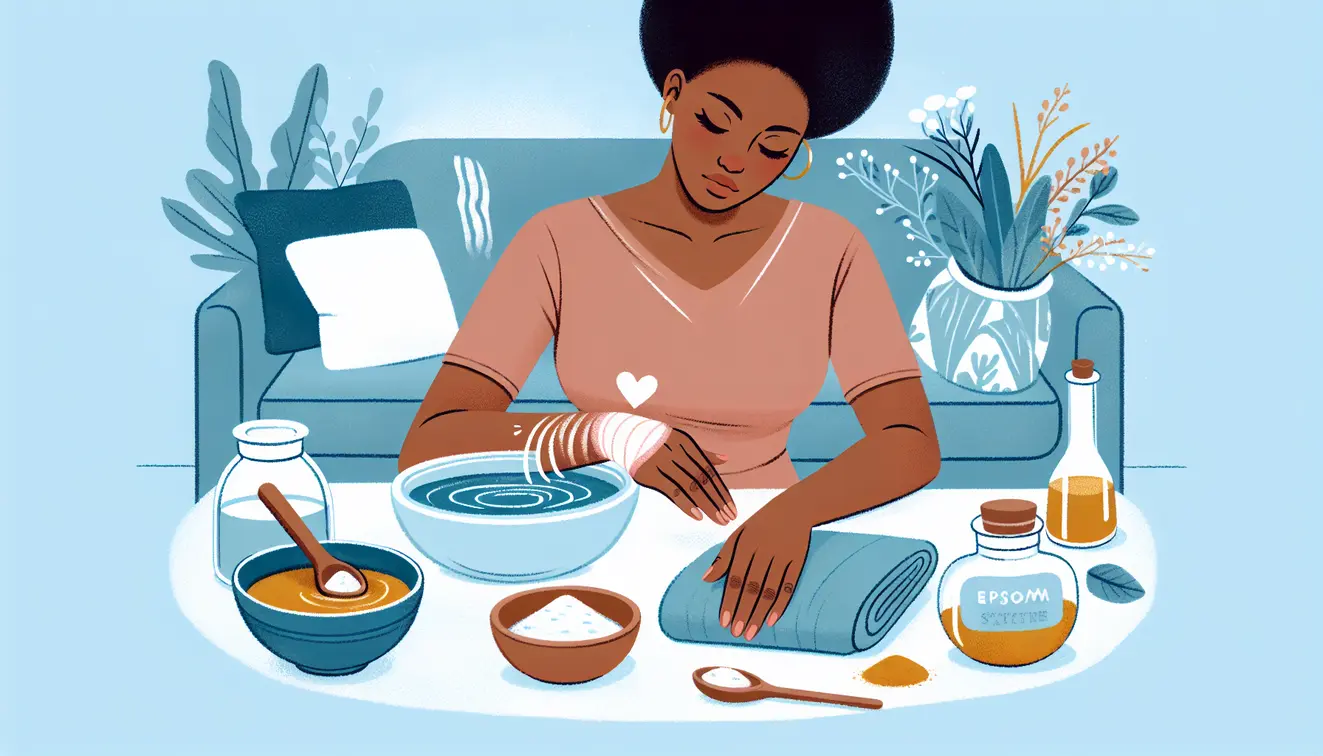Home Remedies for Ganglion Cyst: Natural Relief Tips That Work
Estimated reading time: 10 minutes
Key Takeaways
- Ganglion cysts are non-cancerous, fluid-filled lumps often found near joints like wrists or hands.
- Home remedies can help reduce discomfort and swelling but are not a cure for the cyst itself.
- Safe options include warm compresses, immobilization, and gentle massage, among others.
- Caution is critical—avoid risky practices like smashing the cyst, and seek medical help for worsening symptoms.
- Always balance natural remedies with professional advice when needed.
Table of Contents
- Introduction to Ganglion Cysts and Home Remedies
- Understanding Ganglion Cysts
- Safety and Limitations of Home Remedies
- Effective Home Remedies for Ganglion Cyst Symptom Relief
- Exploratory Natural Remedies with Limited Evidence
- Lifestyle Tips to Prevent Aggravation of Ganglion Cysts
- Debunking Myths and Misconceptions About Ganglion Cysts
- When Home Remedies Aren’t Enough: Signs for Medical Attention
- Frequently Asked Questions (FAQs) About Ganglion Cysts
Introduction to Ganglion Cysts and Home Remedies
Have you noticed a strange lump on your wrist or hand that just won’t go away? It might be a ganglion cyst, a non-cancerous, fluid-filled sac that often appears near joints or tendons, especially on wrists, hands, or feet. These lumps can cause discomfort or mild pain, often due to joint irritation or repetitive stress, and they’re quite common, particularly among people aged 20 to 40, according to the Cleveland Clinic.
Many folks search for gentle, non-invasive ways to manage these cysts at home, and that’s exactly why we’re here. At WikiHomeRemedies, our goal is to guide you through safe and natural solutions for symptom relief. Drawing from trusted insights like those from Mayo Clinic and WebMD, we’ll explore practical home remedies to ease swelling or discomfort. While these tips can help, remember that persistent or worsening symptoms may need a doctor’s attention. Let’s dive into understanding ganglion cysts better and discover how nature’s healing touch can support you on this journey.
Understanding Ganglion Cysts
Ganglion cysts are harmless lumps that form under the skin, often linked to joints or tendons. They’re filled with a thick, jelly-like fluid and typically show up on wrists, fingers, or even ankles. These cysts are more common in women and can vary in size, sometimes growing or shrinking on their own. Knowing what they are and why they form is the first step to managing them wisely.
What Are Ganglion Cysts?
Imagine a small, soft bump that feels like a pea or even a golf ball under your skin. That’s a ganglion cyst. It’s a sac of fluid that often develops near joints, most commonly on the wrist or hand, though feet and ankles aren’t uncommon either. As Healthline notes, these cysts are usually round and can be firm or squishy. While they’re not harmful, their presence can sometimes signal stress in the nearby joint.
Causes and Risk Factors
So, why do these cysts appear? Often, it’s because of fluid leaking from a joint or tendon sheath due to irritation or injury, as explained by the Cleveland Clinic. Repetitive movements, like typing for hours, or past joint trauma can play a role. Certain factors raise the chances of getting one:
- Engaging in repetitive tasks that strain joints.
- Having a history of joint injuries or arthritis.
These elements can quietly contribute to a cyst forming over time.
Symptoms to Recognize
How do you know if it’s a ganglion cyst? Here are the telltale signs, based on insights from WebMD:
- A visible lump under the skin, often painless at first.
- Discomfort or aching when moving the affected joint.
- Tingling or numbness if the cyst presses on a nerve.
These symptoms can vary, with some cysts barely noticeable and others hindering daily tasks.
When to Seek Medical Help
Not all cysts need a doctor’s visit, but certain signs shouldn’t be ignored, per Mayo Clinic guidance:
- Rapid growth or sudden increase in pain.
- Signs of infection like redness, warmth, or pus.
- Restricted movement in the joint near the cyst.
If you spot these, it’s time to reach out for professional advice rather than relying solely on home care.
Safety and Limitations of Home Remedies
Before trying any home remedy, let’s talk about caution. These natural approaches can soothe discomfort or swelling, but they’re not a cure for ganglion cysts. Misusing them or ignoring warning signs might worsen things. At WikiHomeRemedies, we believe in empowering you with safe options, yet we stress that these methods complement—not replace—medical advice. Insights from WebMD warn against risky old practices, like smashing a cyst, which can lead to injury. Understanding the boundaries of home care ensures you’re looking after yourself properly.
Why Caution Matters
Rushing into unproven methods can backfire. For instance, historical tales of hitting cysts with heavy objects—sometimes called “Bible cysts”—sound tempting for quick relief, but WebMD highlights the danger of tissue damage or recurrence. Making informed choices is key. Home remedies aim to ease symptoms, not remove the cyst. If something feels off or pain spikes, it’s wiser to pause and consult someone with medical expertise rather than push forward.
Safety Guidelines for Home Treatments
To keep things safe while exploring natural relief, consider these pointers inspired by Healthline:
- Stop any remedy if pain or irritation worsens.
- Avoid using ingredients you might be allergic to.
- Don’t apply excessive pressure or heat that risks burns.
- Check with a healthcare provider if the cyst shows infection signs.
Following these steps helps ensure your path to relief doesn’t create new problems.
Effective Home Remedies for Ganglion Cyst Symptom Relief
Now that we’ve covered the basics and safety, let’s explore practical ways to manage ganglion cyst symptoms at home. These seven remedies, supported by sources like Healthline and Mayo Clinic, focus on reducing swelling or discomfort. Each comes with clear steps and precautions to keep you on the right track. Remember, consistency matters, but so does listening to your body. Let’s walk through these options together.
Warm Compress Application
A warm compress can work wonders for swelling. Heat boosts blood flow, which may lessen fluid buildup around the cyst, as noted by Healthline. Here’s how to do it:
- Soak a clean cloth in warm water, not hotter than 110°F (43°C).
- Wring it out and place it over the cyst for 15 to 20 minutes.
- Repeat two to three times daily for relief.
Be gentle—avoid scalding heat that might burn your skin. If it feels uncomfortable, cool the cloth slightly.
Immobilization with Brace or Splint
Reducing joint movement can cut down irritation. The Cleveland Clinic suggests using a brace or splint to rest the area. Try this:
- Choose a brace that fits snugly around the wrist or affected joint.
- Wear it during activities that strain the area, like typing.
- Remove it periodically to prevent stiffness.
Don’t keep it on too long—overuse might weaken muscles. Balance rest with gentle movement after a few hours.
Gentle Massage Techniques
Massaging around the cyst may improve circulation and ease tension. Verywell Health mentions this as a supportive step. Follow these tips:
- Use clean hands or a small amount of unscented lotion.
- Rub gently in circular motions around—not directly on—the cyst for 5 minutes.
- Do this once or twice daily if it feels soothing.
Stop immediately if pain spikes. This should relax the area, not stress it further.
Over-the-Counter Pain Relievers
For nagging discomfort, over-the-counter options like ibuprofen or acetaminophen can help. WebMD outlines their use for temporary relief. Keep these in mind:
- Follow the dosage on the label—don’t exceed recommended amounts.
- Take with food to avoid stomach upset.
- Watch for side effects like nausea or drowsiness.
These aren’t a fix for the cyst itself, just a way to manage pain. Consult a doctor if you need them often.
Epsom Salt Soaks
Soaking in Epsom salt is a traditional remedy some swear by for swelling. While evidence is limited, StyleCraze notes its calming effect. Here’s the process:
- Dissolve 2 tablespoons of Epsom salt in a basin of warm water.
- Soak the affected area for 15 to 20 minutes.
- Pat dry and repeat daily if it helps.
Watch for skin dryness or irritation. Stop if the soak causes any stinging sensation.
Turmeric Paste Application
Turmeric’s natural properties might calm inflammation, a use mentioned by Verywell Health in traditional practices. Try this at home:
- Mix 1 teaspoon of turmeric powder with a few drops of water to form a paste.
- Apply a thin layer over the cyst and cover with a clean cloth.
- Leave for 30 minutes, then rinse off; repeat daily.
Be aware it can stain skin or fabric. Test a small area first to avoid reactions.
Frankincense Essential Oil
Frankincense oil is often praised in traditional care for easing inflammation, per Verywell Health anecdotes. Use it safely like this:
- Dilute 2 to 3 drops of frankincense oil with a tablespoon of carrier oil like jojoba.
- Dab gently around the cyst using a clean cotton pad.
- Apply once daily and monitor for effects.
Always patch-test on a small skin area first. Discontinue if redness or itching appears.
Exploratory Natural Remedies with Limited Evidence
Curiosity often leads to alternative remedies, and while some are popular, solid science doesn’t back them up. We’ll look at three options—apple cider vinegar, castor oil, and ginger compress—that users discuss on platforms like Earth Clinic. At WikiHomeRemedies, we’re upfront: these lack robust evidence, per Mayo Clinic standards. Try them with an open mind but a cautious approach. If they don’t suit you, that’s okay—there are other paths to explore.
Apple Cider Vinegar Soaks
Some claim apple cider vinegar reduces cyst size, though proof is scarce, as Earth Clinic notes. If you’re curious, here’s a method:
- Mix 1 part vinegar with 3 parts warm water in a small bowl.
- Soak a cloth in the solution, apply to the cyst for 15 minutes daily.
- Rinse the skin after to avoid irritation.
There’s no guarantee this works, and vinegar might sting sensitive skin. Stop if it feels wrong.
Castor Oil Packs
Castor oil is a traditional choice for inflammation in some circles, per StyleCraze, but studies are absent. To experiment:
- Soak a clean cloth in castor oil and place it over the cyst.
- Cover with a warm towel for 20 to 30 minutes once daily.
- Wash the area thoroughly afterward.
This isn’t a proven fix. If the oil causes a rash, discontinue use right away.
Ginger Compress
Ginger’s warming effect is tied to reducing inflammation in folklore, though evidence is thin. If you’d like to try:
- Grate fresh ginger, wrap it in a cloth, and steep in hot water for 5 minutes.
- Let it cool slightly, then apply to the cyst for 10 to 15 minutes.
- Repeat daily if it feels comforting.
This is purely anecdotal. Skip it if the heat or ginger irritates your skin.
Lifestyle Tips to Prevent Aggravation of Ganglion Cysts
Beyond remedies, small daily changes can stop a cyst from getting worse. Repetitive strain often fuels these lumps, so easing that stress is vital. The Cleveland Clinic emphasizes joint care, and simple habits can make a difference. For instance, if your wrist cyst flared up from endless typing, take short breaks to rest your hands. Pacing yourself during tasks protects the area from further irritation.
Consider supportive gear as well. If the cyst is on your foot, Medical News Today suggests padded shoes or insoles to cushion the joint. Avoid tight footwear that presses on the lump. For related foot concerns like plantar fasciitis, which can also cause discomfort near joints, check out additional tips here: Home Remedies for Plantar Fasciitis. For wrists, mindful ergonomics—like adjusting your desk setup—can help. After consulting a doctor, gentle stretches might maintain joint health without overdoing it. These steps aren’t a cure, but they support your body’s natural balance and may prevent discomfort from spiking.
Debunking Myths and Misconceptions About Ganglion Cysts
Misinformation about ganglion cysts lingers, and it’s time to clear the air. One old notion is that hitting the cyst with a heavy object, like a book, makes it vanish. WebMD and Mayo Clinic strongly warn against this—it risks injury, infection, or recurrence, doing more harm than good. At WikiHomeRemedies, we want you equipped with facts, not risky shortcuts.
Another false idea is that home remedies can fully erase a cyst. They’re for symptom relief, not removal. If the lump persists, medical options like aspiration or surgery might be the next step. Believing natural methods always suffice can delay needed care. Trustworthy guidance means knowing when to try home solutions and when to seek a professional. Let’s focus on what truly supports your well-being, leaving outdated tales behind.
When Home Remedies Aren’t Enough: Signs for Medical Attention
Sometimes, home remedies fall short, and that’s perfectly okay. Certain signs mean it’s time to see a doctor, ensuring you don’t overlook something serious. Mayo Clinic points out key red flags to watch for, like numbness in nearby fingers, hinting at nerve pressure. If the cyst grows quickly or shows infection signs—think redness or warmth—don’t wait. Restricted joint movement is another cue to get checked.
Medical options exist when natural paths don’t cut it. Aspiration, where a doctor drains the fluid, or surgery for stubborn cysts, are common, per Healthline. When booking that appointment, be ready to share what remedies you’ve tried and how the cyst behaves. Note pain levels or size changes. This helps your provider tailor the best plan. Knowing when to step up to professional care is just as vital as starting with home solutions.
Frequently Asked Questions (FAQs) About Ganglion Cysts
What causes a ganglion cyst to form?
Ganglion cysts often stem from fluid leaking out of a joint or tendon sheath, usually due to irritation or injury. Repetitive stress, like constant wrist motion, or past trauma can trigger this, as the Mayo Clinic explains. While the exact reason isn’t always clear, joint strain plays a big role in their development.
Can a ganglion cyst go away on its own?
Yes, many ganglion cysts disappear without any treatment. The Cleveland Clinic notes that they can shrink naturally over time, especially if you rest the affected area. Patience is key, though—if symptoms persist or worsen, it’s worth a closer look.
Are home remedies effective for all cysts?
Home remedies focus on symptom relief, not curing the cyst itself. They might ease pain or swelling for some, but as WebMD clarifies, they don’t work for everyone or guarantee the lump will vanish. They’re a starting point, not a full solution.
Is it safe to pop a cyst at home?
No, attempting to pop or smash a ganglion cyst is dangerous. WebMD warns it can lead to infection, injury, or recurrence. Resist the urge and consider safer options or medical advice to handle the lump properly.
How long should I try remedies before seeing a doctor?
Give home remedies about 2 to 4 weeks to show an effect, unless symptoms get worse sooner. If pain increases, the cyst grows, or new issues arise, don’t delay a doctor’s visit. Prioritizing your health means knowing when to seek expert help, as Healthline advises.










